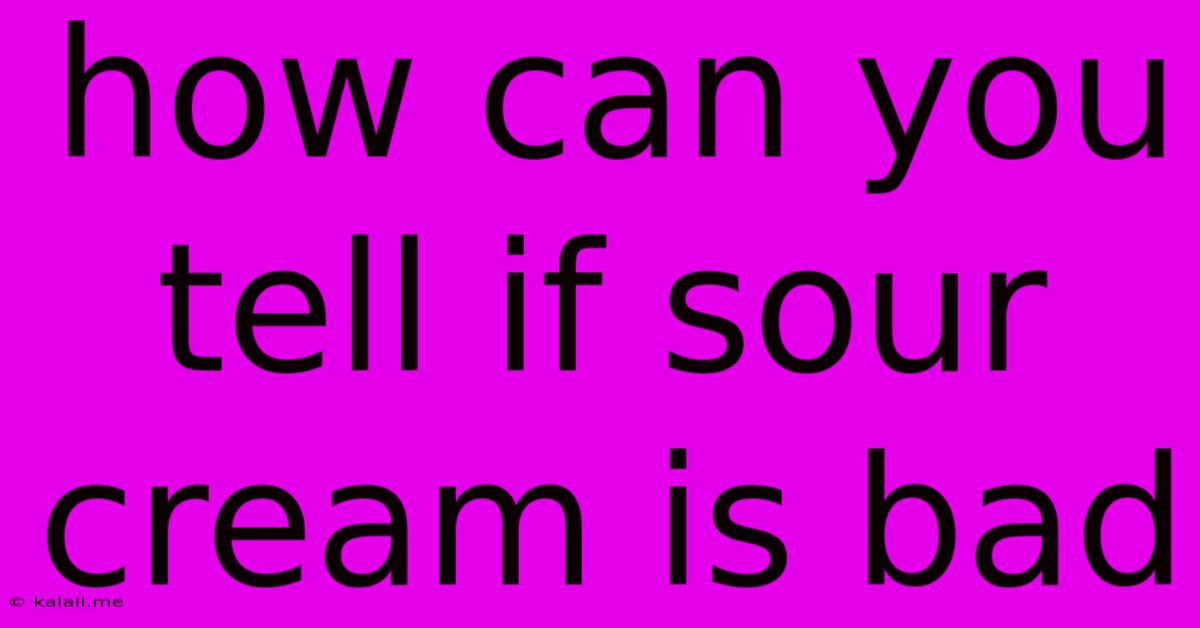How Can You Tell If Sour Cream Is Bad
Kalali
May 24, 2025 · 3 min read

Table of Contents
How Can You Tell if Sour Cream is Bad? A Guide to Avoiding Spoiled Dairy
Sour cream, that creamy, tangy delight, is a staple in many kitchens. But like any dairy product, it has a limited shelf life. Knowing how to spot spoiled sour cream is crucial to preventing foodborne illness and avoiding waste. This guide will walk you through the key signs to look for, helping you determine if your sour cream is still safe to eat.
Understanding Sour Cream's Shelf Life
The "best by" date on your sour cream container is a guideline, not a hard and fast rule. While sour cream past this date might still be safe, its quality and flavor will likely have degraded. Proper refrigeration is key; sour cream should always be kept at or below 40°F (4°C). Once opened, its shelf life significantly shortens, typically lasting about 1-2 weeks.
Visual Clues: Seeing is Believing
Several visual cues can indicate that your sour cream has gone bad. Pay close attention to:
- Changes in Color: Fresh sour cream is typically a creamy white or pale yellow. If you notice significant discoloration, such as yellowing, browning, or even greenish hues, it's a strong sign of spoilage. Mold growth, although rare in properly refrigerated sour cream, will present as visible fuzzy patches.
- Unusual Texture: Spoiled sour cream often develops a watery or separated appearance. You might see a liquid whey separating from the creamy base, or a change in consistency; it might be thinner or chunkier than usual. A slimy or overly thick texture is also a warning sign.
- Mold Formation: While less common than other signs, visible mold is a definitive indicator of spoilage. Discard the sour cream immediately if you see any mold growth.
Smell Test: Trust Your Nose
Your sense of smell is a powerful tool in determining food safety. Give your sour cream a good sniff. If it smells significantly different from its usual tangy aroma—perhaps sour, putrid, or even slightly sweet—it's time to toss it. A sour smell is expected to some degree, but an unusually pungent or off-putting odor signifies spoilage.
Taste Test (Proceed with Caution!)
This method is the least recommended as it involves consuming potentially spoiled food. However, if you're still unsure after a visual and smell inspection, you can take a tiny amount and taste it. If it tastes overly sour, bitter, or otherwise unpleasant, discard it. Never consume a significant amount if you suspect spoilage.
How to Extend Sour Cream's Shelf Life
- Proper Storage: Always refrigerate sour cream immediately after purchase and keep it consistently cold.
- Airtight Container: Transfer opened sour cream to an airtight container to prevent exposure to air and moisture.
- Freezing: Sour cream can be frozen, although the texture might change slightly after thawing. It's best used in cooked dishes after freezing.
Conclusion: When in Doubt, Throw it Out
While a few days past the "best by" date might not necessarily mean your sour cream is unsafe, prioritizing food safety is paramount. If you have any doubts about the quality of your sour cream based on its appearance, smell, or taste, err on the side of caution and discard it. It's better to prevent potential food poisoning than risk your health. Remember, preventing foodborne illness from spoiled dairy products is always the top priority.
Latest Posts
Latest Posts
-
Far Cry 3 Wild Boar Location
May 24, 2025
-
Google Maps Gas Stations Near Me
May 24, 2025
-
Copy File From Ssh To Local
May 24, 2025
-
Can You Put Caulk Over Grout
May 24, 2025
-
Just Dont Call Me Late For Dinner
May 24, 2025
Related Post
Thank you for visiting our website which covers about How Can You Tell If Sour Cream Is Bad . We hope the information provided has been useful to you. Feel free to contact us if you have any questions or need further assistance. See you next time and don't miss to bookmark.